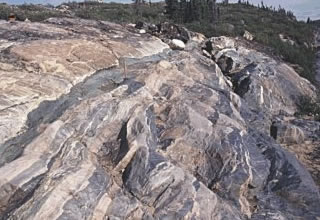Metamorphic Rocks
Acasta Gneiss in the Slave Province
The word metamorphic means "of changed form." Metamorphic rocks are rocks that have been changed from one form, such as igneous or sedimentary, to another. This can occur when a given rock is exposed to intense heat, pressure, or hot fluids.
Recalling igneous rocks, the specific rock that forms from a given magma depends on the components of the magma, the temperature at which the magma cools, how quickly the magma cools and also the pressure at which the rock forms. As materials crystallize, the atoms form a structure that is most stable at the temperature and pressure of the environment where it is forming.
Imagine a group of people filling a small room. If only a few people are in the room there is plenty of space for people to spread out and move around while they talk. However, as more and more people enter the room, those same people no longer have the same space and may have to adjust their bodies to become more comfortable.
Although, rocks differ significantly from people, pressure and temperature will have the same effect on the atoms that make up the rock. As pressure or temperature increases, the atoms that make up the original rock must rearrange themselves in order to form a more stable or "comfortable" structure, just as people in a room. However, since rocks are made of minerals and each mineral has a specific chemical structure and form, changing the structure and or form will then change the mineral.
The type of metamorphic rock that can form depends on the rock that is being metamorphosed as well as the amount of pressure and heat to which the rock is exposed. Since varied temperature and pressures will produce different minerals, the exact type of metamorphic rock produced depends on the grade (intensity) of metamorphism. The grade of metamorphism can most often be determined by the minerals present within the metamorphic rock and the type of rock formed. Some of the more common metamorphic minerals include quartz, feldspar, biotite, muscovite, chlorite, garnet, tourmaline, calcite, and amphibole. The rock that has undergone change is called the parent rock. Parent rocks can be any of the three types of rocks: igneous, sedimentary, or even metamorphic rocks which can be metamorphosed again.

